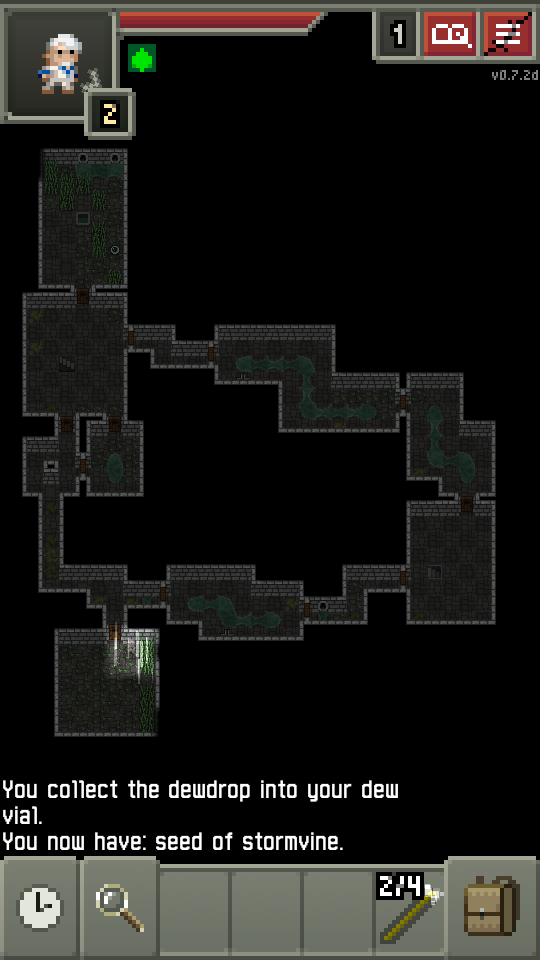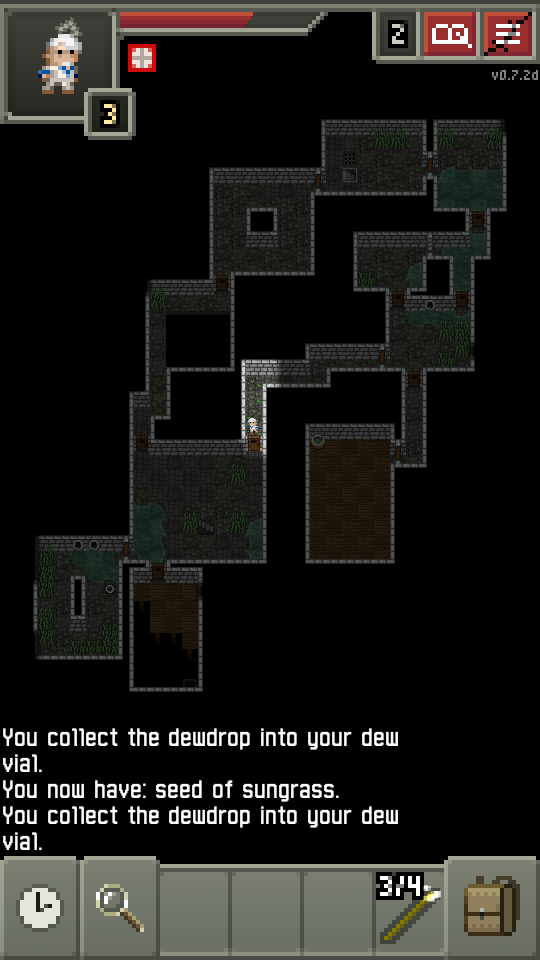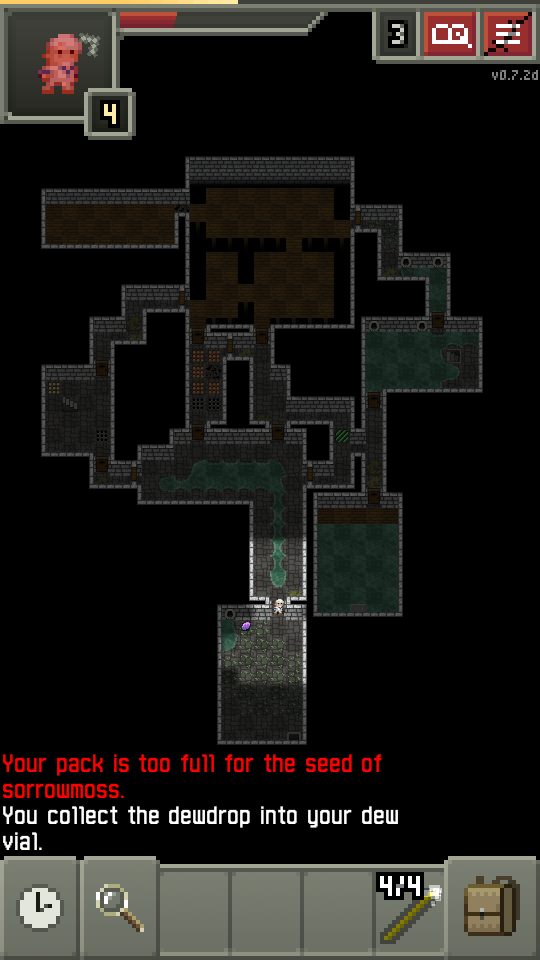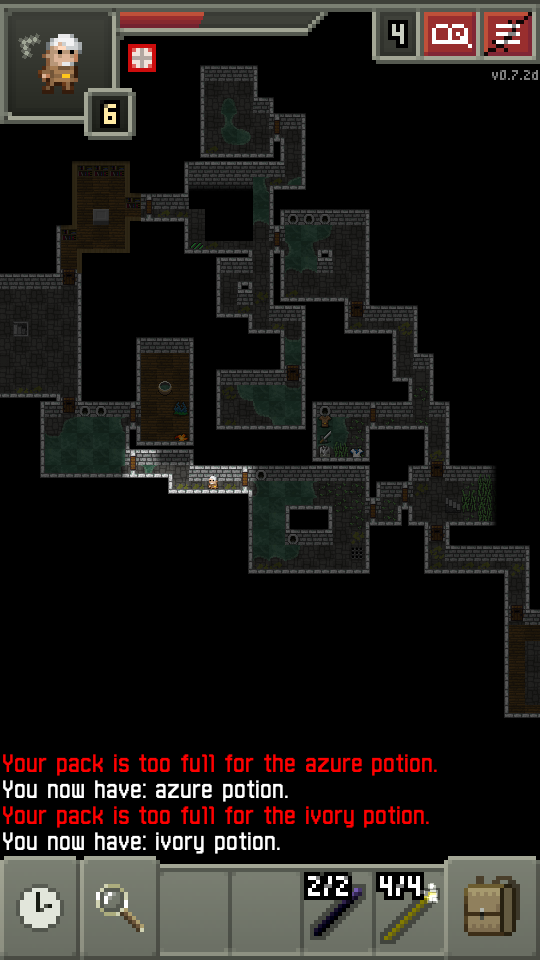Shattered Dungeon's Level Generation
In my previous post, I covered Pixel Dungeon’s level generation which relied on the subdivision of a rectangular region. I’ve decided to check if the popular fork Shattered Pixel Dugneon had any significant changes and I was fairly surprised by what I found. Shattered throws away the underlying level generation process which was bounded by a finite rectangular region and replaces it with one that is unbounded but still confined to grid cells. This required significant changes and increased the complexity of level generation but increases the freedom of level configurations.
If you read the previous post be careful about applying any concepts learnt there onto
Shattered. The only concepts that remain the same are rectangles and that rooms
are defined as a rectangular region. In Pixel the type of room was encoded
as a enumerator whereas in Shattered the type is based on its class. Each room
can dictate what its dimensions are and how many connections to it are allowed.
A new concept called Builder is used for level generation and contains two major
functions called placeRoom and findFreeSpace. Different builders inherit
from Builder and provide different build functions that are responsible for
a collections of rooms that are connected. The most notably descendent of Builder
is LoopBuilder which is used for the typical dungeon level. I’ll first explain
findFreeSpace and placeRoom before explaining LoopBuilder.
findFreeSpace
Given a point and a collections of rooms maximize the rectangular space around the
point without overlapping any rooms. If a point is contained within any room
then there is no free space. Also we don’t want a space of infinite size so we have
a maximum distance from the point called maxSize.
Here is a general description of the algorithm.
Let p be provided point.
Let rooms be the provided rooms.
Let maxSize be the maximum distance from p.
Initialize a rectangle called space with dimensions
(p.x - maxSize, p.y - maxSize, p.x + maxSize, p.y + maxSize)
Now while the size of rooms is not zero perform the following:
Iterate through all the rooms removing any empty rooms or rooms that do not overlap space.
Now the first element in rooms will be non-empty and will overlap space, pop it off and call it r.
If the point is contained within this room, then return an empty rectangle, otherwise
modify space in the smallest way possible so it does not overlap this room, which
can be accomplished as follows. When reducing space we only need reduce its
width or its height but not both. The dimension we perform the reduction on is the
one that removes the minimum area from space. Set wDiff and hDiff to infinity,
if r.left >= p.x
wDiff = (space.right - r.left) * (space.height() + 1)
else if r.right <= p.x
wDiff = (r.right - space.left) * (space.height() + 1)
if r.top >= p.y
hDiff = (space.bottom - r.top) * (space.width() + 1)
else if r.bottom <= p.y
hDiff = (t.bottom - space.top) * (space.width() + 1)
if (wDiff < hDiff) == 0){
if (r.left >= p.x && r.left < space.right) space.right = r.left;
if (r.right <= p.x && r.right > space.left) space.left = r.right;
} else {
if (r.top >= p.y && r.top < space.bottom) space.bottom = r.top;
if (r.bottom <= p.y && r.bottom > space.top) space.top = r.bottom;
}
As stated previous we continue this until rooms is empty which
after repeated iterations obtains the free space around a point if one exists.
Here is visual of the above
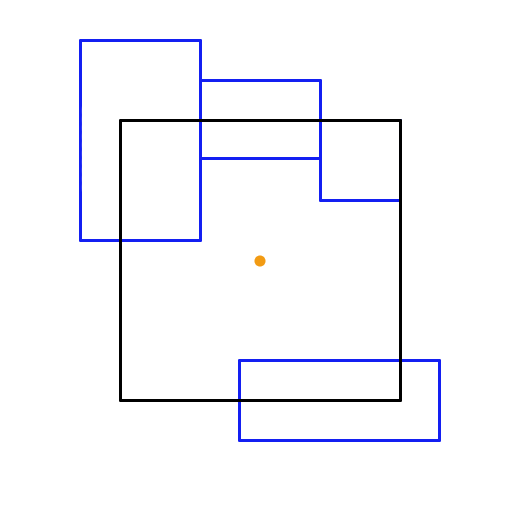
This is the actual source code for findFreeSpace.
placeRoom
Given a non-empty room and an empty room, we want to initialize the empty room
next to non-empty room and have placed at a certain angle. We also want to ensure
that we can connect these two rooms.
Here are the parameters this function takes:
A collections of rooms called rooms.
The non-empty room called from.
The empty room called to.
An angle called angle.
We determine the center of the non-empty and cast a ray with an angle of angle
from this point. We then determine where this ray intersects one of our bounding
walls. Now determine the free space around this point by calling findFreeSpace and
attempt to initialize the empty room using this free space. Given the dimensions
of the new room we extend the previously cast ray to determine the ideal center
for this new room and adjust the position accordingly. Then shift the new room
so it shares a wall with from. Now since we shifted the new room around it may
not be within the bounding region determined by findFreeSpace so we perform any
necessary shifts to nudge it back in.
Finally attempt to connect the new room and from.
There are three main points where this process can failure, findFreeSpace can fail,
the free space is too small for the room, and the connect function can failure if
the two rooms don’t share a wall.
This is the actual source code for placeRoom.
LoopBuilder
I’ll explain a simplified version of the LoopBuilder to help build an intuitive understanding of it.
The goal is given a collection of uninitialized rooms, we want want to connect them
in circular pattern and ensure that a loop exists. Each level creates a collection of rooms, rooms,
that must appear in the level. A shallow copy of these rooms are created and
are filtered into two collections, MultiConnections, and SingleConnections.
Only rooms from MultiConnections can appear on the path since at least two
connections are required for rooms in a cyclic path.
The path will contain a portion of rooms from MultiConnections this portion is called, pathLength, thus
this path will contain MultiConnections.length() * pathLength rooms from MultiConnections.
Now a create room containing the entrance and set it at the origin (0,0),
create a collection called path, add the entrance to it, and while we
have rooms left to be placed do the following:
- Pop a room from
MultiConnectionsand push it ontopath - Randomly add
ConnectionRoomtopath. This ensures 0 or more tunnels exists between each room.
After this process is complete we add the exit room in the middle of the path collection.
Now create a reference called prev which refers to the last room placed. It is initialized
to the entrance room, which is the first room in path.
Now beginning at the second room in path for each room do the following:
Let the current room be referred to as curr.
- Calculate the target angle,
angle, for the current room. - Call
placeRoomwith parametersrooms,prev,curr,angle. - Set
prevtocurr
The target angle can be calculated as follows:
Let i be the index of the room in loop
Let s be the size of loop
angle = 360 * (i/s)
This is a lerp (Linear interpolation) between the angles 0 and 360.
Also recall that placeRoom can fail and if it does we have to retry the
entire level.
The path is not yet complete! The above procedure does not connect the last room and the entrance so we handle that
case, thus completing the loop. Any remaining rooms in
MultiConnections and SingleConnections must be added. These rooms are uninitialized
so for we randomly select an initialized room, generate a random angle, and attempt
to connect the new room. During this we may also add additional ConnetionRooms between the two rooms.
Rooms placed in this manner are referred to as branch rooms.
Afterword
I initially found this level generator harder to analyze compared to Rouge’s and Pixel Dungeon’s generators mostly because there are multiple edge cases that can occur throughout the process. I painted some broad strokes with the overall process and some details were left out. The most notable is the equation for target angle can lerp the angles of an oval. I found Shattered approach to be fairly insightful and was definitely worth a look over. Finally here are some screenshots of the end result.
